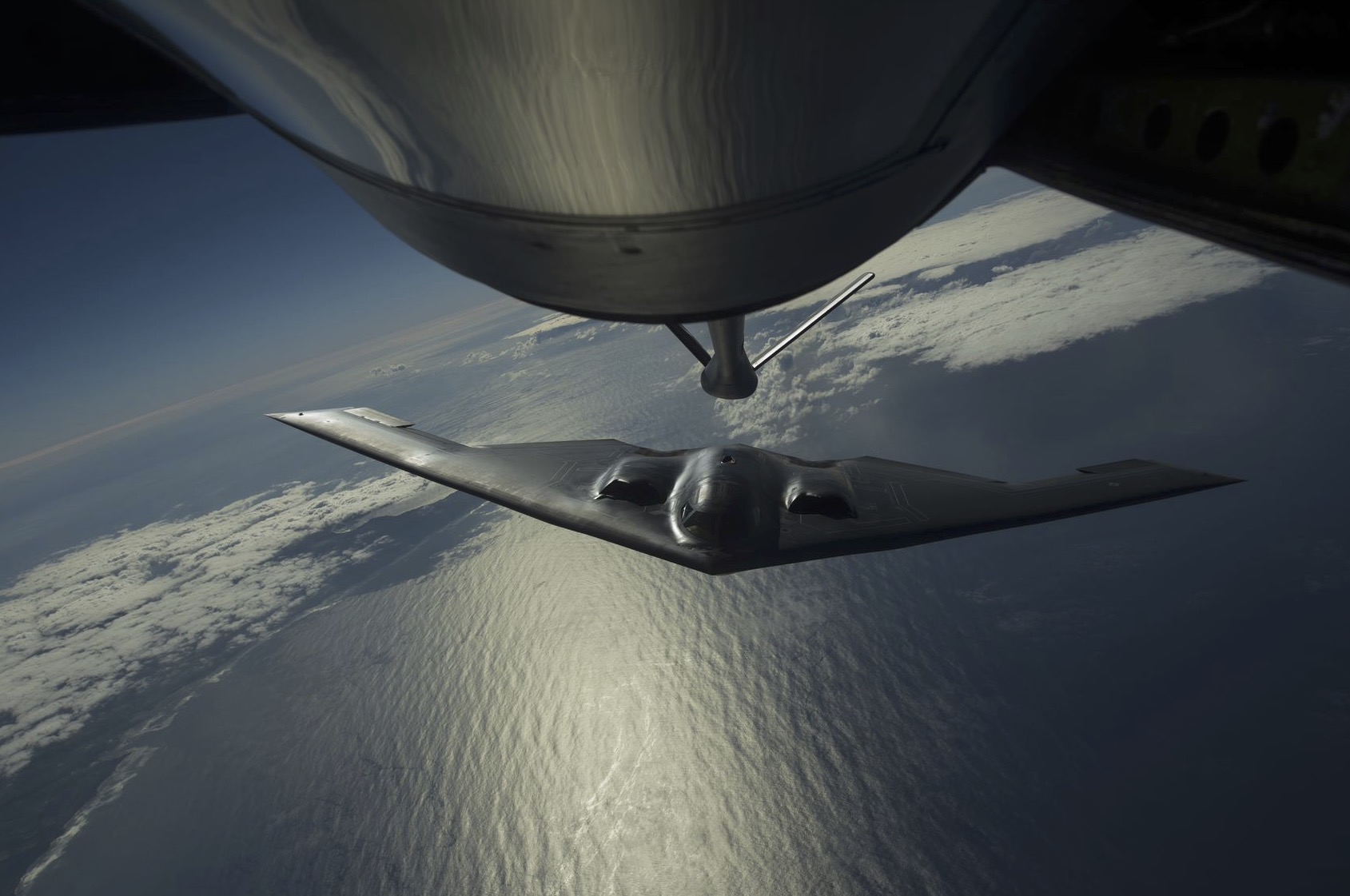
A B-2 takes on fuel near JB Pearl Harbor-Hickam, Hawaii. The B-2 is scheduled for retirement before the B-21 bomber’s initial production allotment is completed. Photo: MSgt. Russ Scalf
The United States faces an inflection point regarding how it projects power in an environment defined by burgeoning threats and a complex set of security imperatives. Since the end of the Cold War, Americans have rightfully assumed their nation possessed military superiority, no matter the situation.
Today, however, that assumption is radically changing.
We are now in an era where multiple competing nations are concurrently developing strategies and fielding advanced capabilities specifically designed to counter US combat power. As the Senate Armed Services Committee declared in 2018:
“The array of national security threats facing the United States is more complex and diverse than at any time since World War II. The strategic environment has not been this competitive since the Cold War. Simply put, America no longer enjoys the comparative edge it once had over its competitors and adversaries.”
Opponents have observed America’s long-established pattern of operations and are developing methods to negate our strategies. The 2001 Quadrennial Defense Review predicted as much 18 years ago: “Future adversaries could have the means to render ineffective much of our current ability to project power overseas. Saturation attacks with ballistic and cruise missiles could deny or delay US military access to overseas bases, airfields, and ports.” That “future” is now.
It is necessary to reassess long-held assumptions regarding the capability and capacity of US military force structure, in particular the size of the Air Force’s bomber fleet—which is now the smallest it has been since the founding of the service in 1947.
America ended the Cold War with over 400 bombers arrayed to fight one enemy—the Soviet Union. Countering multiple adversaries demands a more capable hybrid force comprised of new B-21s, as well as modernized legacy bombers—the B-1B, B-2, and B-52.
Bombers are the most cost-effective option to deliver long-range, rapid power projection capacity and capability to combatant commanders around the globe. In the Mitchell Institute’s recently released study, Building the Future Bomber Force America Needs: The Bomber Re-Vector, we make the case to grow the Air Force inventory to a force of 270 bombers: 180 B-21s, plus 90 legacy bomber aircraft. This approach departs from the Air Force’s current plan to retire the B-1B and B-2 before the B-21’s initial production allotment is completed, a budget- and personnel- driven decision that preceded the release of the new National Defense Strategy in 2018. The Air Force plan would yield a force of 175 bombers, inadequate to meet the requirements of the National Defense Strategy. Premature divestiture of legacy bombers risks an even greater shortage in the event of B-21 production delays or a curtailed buy. History teaches it is unwise to divest a capability until the replacement is guaranteed.
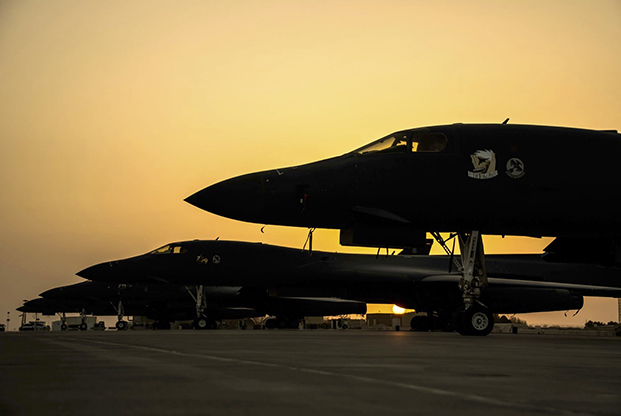
B-1Bs on the flight line at al Udeid AB, Qatar. Older, nonstealthy bombers such as the B-1B complicate an enemy’s defense calculus with standoff missile capabilities. Photo:TSgt. Ted Nichols
FORK IN THE ROAD
The new National Security Strategy, the growing near-peer threats of China and Russia, and continued instability in regions like the Middle East mandate that the nation close the gap between real-world demand and available force structure. Failing to pursue this path will see valuable strategic, operational, and tactical options fall off the table. The Department of Defense has few options when it comes to long-range power projection on a global level. A good “Plan B” does not exist without bombers. The new B-21—if procured in sufficient numbers—paired with a modernized B-52, B-1B, and B-2 force can avert the current shortfall and ensure security requirements are met years into the future.
The high end of the conflict spectrum is more dangerous than ever. As the 2018 National Defense Strategy explains: “Deterring or defeating long-term strategic competitors is a fundamentally different challenge than the regional adversaries that were the focus of previous strategies.” Nations around the globe are turning to overtly aggressive actions to advance their interests.
China is harnessing attributes of hard power to expand its territorial claims in the South China Sea and beyond. Russia is willing to engage in blatant acts of hostility in places like eastern Ukraine and Syria. North Korea is aggressively pursuing nuclear weapons, and Iran is continuing its adversarial actions across the Persian Gulf. All the while, the threat posed by nonstate actors continues to evolve in new, challenging ways. The globe is increasingly unstable, and highly predictable regions are now buffeted by significant change. US interests and priorities are at risk with both military capabilities and capacity stretched thin.
The burgeoning threat environment is also of increasing concern because adversaries now have the means to execute their strategies due to concerted investment in a new generation of advanced military capabilities. This list includes advanced air defense systems; long-range precision strike; deployed, decentralized airborne command and control; robust ISR functions; and enhanced computing capacity. Enemy commanders will be able to target American and allied forces with an incredibly lethal combination of range, precision, and mass.
These threats have not existed since the Cold War. Strategies, operational practices, and hardware of the last century can no longer be assumed to be “good enough.” Factors like wartime attrition and reserve must be seriously considered once again. Mass, concurrent, and survivable power projection becomes increasingly important given the scale and scope of these new challenges.
With adversaries aggressively pushing forward, the Air Force must act fast to realign its capabilities and capacity with a requirements-driven force, not one shaped by arbitrary budget targets. It is not just about buying more of what the service already has; it is about generating the right balance of capabilities.
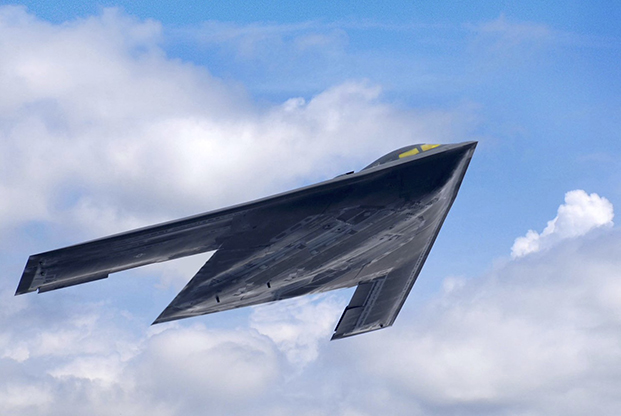
An artist’s concept of the B-21 bomber. The B-21 must be procured in sufficient numbers to avert a coming bomber shortfall. Staff illustration
BOMBER TOOL KIT
Looking to the future, attributes of the right force balance include:
- Range. The bomber force must be able to strike nearly any target, no matter its distance. Many key facilities lie deep within adversary territory, and bombers are one of the few assets capable of reaching these targets early in a conflict. Range also enhances survivability. It permits the bomber force to operate from bases beyond the reach of our adversaries’ anti-access capabilities and lessens our reliance on tankers.
- Responsiveness. The bomber force must react quickly to emerging crises around the globe. Unlike other elements of the joint force, bomber response time is measured in hours—not days, weeks, or months. Further, bombers can move easily from one theater to another, potentially from the same base. This strategic flexibility is particularly critical in a multipolar world.
- Payload. This gives the bomber force the ability to bring a large number of weapons and highly specialized capabilities into the fight. This includes swarms of cheap munitions to swamp adversary air defenses, specialized penetrators to defeat deeply buried targets, powerful sensors to better understand the battlespace, and potentially nonkinetic payloads that support integrated systems destruction warfare.
- Survivability. Aircraft that feature stealth technology like the B-2 and the B-21 can strike targets anytime, anywhere. Older nonstealthy bombers, such as the B-1B and B-52, can also complicate an enemy’s defensive calculus at the high end of the threat spectrum by using standoff missile capabilities and ISR to locate targets. The combination imposes steep costs on an enemy and radically complicates defense strategy.
- Versatility. Regardless of type, all bombers now execute missions that extend beyond their historic roles as long-range, air-to-ground strategic attack and interdiction strike aircraft. Additional mission areas include counter-sea attack; ISR; persistent direct attack; close air support; and electronic warfare. Future growth areas include deployed, airborne decentralized command and control capability as integral elements of the combat cloud, and new technologies like hypersonic munitions, directed-energy weapons, and cyber-attack tools.
From an airpower perspective, these essential attributes point to a common capability: long-range sensor-shooters. Operating across long distances, carrying large loads, fielding sensor and processing capabilities, and transiting anywhere on the globe in a matter of hours, the defining virtues of the bomber force speak directly to the attributes required for this new threat environment.
These aircraft will radically complicate an enemy’s defensive calculus and yield valuable options for US commanders.
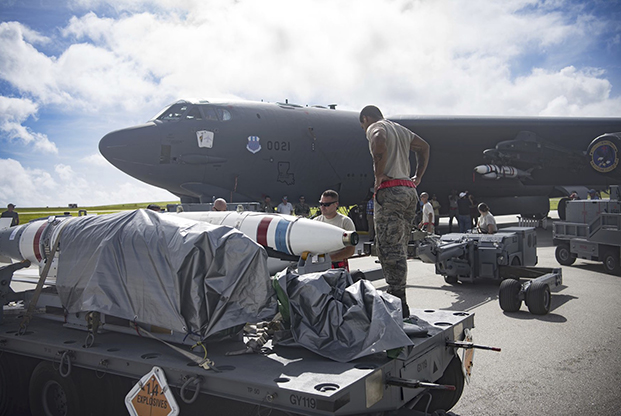
Airmen prepare to load a Quickstrike-Extended Range mine onto B-52s at Andersen AFB, Guam. BUFFs are expected to remain in service through 2050, completing some 100 years of service. Photo: SrA. Zachary Bumpus
BIGGER AND YOUNGER FORCE
Bombers’ strengths are not reflected elsewhere in the current defense inventory. Naval vessels are slow and increasingly vulnerable to modern weapons. Land forces require significant deployment time, are vulnerable to attack once employed, and lack extended power-projection capabilities. The majority of the nation’s airpower portfolio consists of short-range aircraft, with limited payload carriage. Thus, the argument for long-range sensor-shooters is simple—maximize the capability to rapidly project power. Viewed from a cost-per-effect perspective, it may also be termed “mission-based affordability,” because desired combat effects are realized so efficiently.
Force size also matters. In the years after the Cold War, US forces faced comparatively mild anti-air threats, which resulted in relatively few losses compared to earlier conflicts. Future threats point to higher attrition risks, which must be factored into the force structure. Additionally, unlike the limited regional conflicts of the post-Cold War era, future wars will likely encompass larger operating areas—increasing demand for a greater number of bomber aircraft.
America’s present bomber force is too small to meet the tenets of the nation’s defense strategy. The “peace dividend” paid out following the Cold War radically reduced USAF long-range strike capacity from 661 airframes when the Berlin Wall fell to 157 aircraft in 2018—a 76 percent reduction in bomber aircraft. The B-2 acquisition was slashed by 85 percent, and the B-1B and B-52 force was cut by half. While resources were focused on making the remaining bombers more effective through introduction of precision-strike capabilities and a range of other upgrades, a small force, no matter how capable, can only be stretched so thin on the global stage in an era where threats are on the rise.
The backdrop to this was the combined impact of downsizing, combat operations in Afghanistan and Iraq, and the Budget Control Act of 2011—which cut several vital force modernization efforts. Multiple continuing resolutions further eroded finite investment and contributed to today’s compromised airpower capabilities. As Secretary of the Air Force Heather Wilson remarked: “We have an Air Force that is the oldest Air Force and the smallest Air Force in its history.” Former Senate Armed Services Committee Chairman John S. McCain declared, “This is a full-blown crisis, and if left unresolved, it will call into question the Air Force’s ability to accomplish its mission.”
While the acquisition of the B-21 certainly stands as a crucially important decision in reshaping America’s military defense portfolio, the current Air Force “bomber vector” suggests that the service is planning an inventory of only 175 bombers—B-21s and B-52s, with B-1Bs and B-2s retired in the 2030s.
This risks retiring aircraft before their replacements are fully fielded and fully capable and is simply inadequate for today’s security environment. Decisions must focus on mission requirements, not just up-front cost.
To build the force structure needed for the 21st century, the Air Force should consider retaining and modernizing its B-1Bs and B-2s until it can procure B-21s in larger numbers. This additive approach—in combination with the stated intent to retain and modernize the B-52—builds the bomber inventory and closes the gap between demand and available assets. It also answers the demonstrated requirement to meet both high-end mission demands in increasingly complex threat environments, while also allowing efficient power projection against long-standing nonstate actors and other persistent adversaries. The Air Force must advocate for greater resources to fund this need.
Potential adversaries are well aware of the capacity challenges facing the US military and are emboldened to press forward aggressively because they believe the US will be self-deterred from engaging. An inadequate set of tools will result in lost lives, ceded mission objectives, and the risk of defeat in war.
A larger long-range, sensor-shooter force, however, will deter enemy action and stabilize the world against aggression. Preventing war is always cheaper than fighting one.
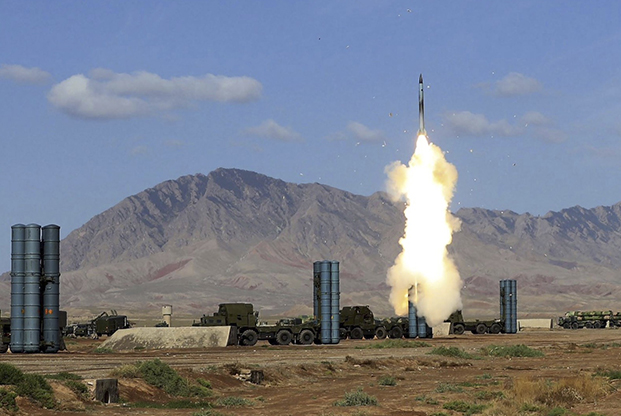
A Chinese S-300 air defense missile system fires at an aerial target. The new National Defense Strategy identifies China as a near-peer threat. Photo: Fu Kaichun, Wang Haijun, and Chenlei via chinamil.com.cn
BACK TO THE FUTURE
The Mitchell Institute recommends a nine-step course of action to increase the capability and capacity of America’s long-range bomber force:
- B-21 acquisition. The Air Force should aim to procure at least 180 B-21s and increase the production rate to meet growing demand for penetrating strike capability and provide highly survivable long-range sensor-shooter platforms for a variety of emerging missions.
- Bomber retirements. To build the force structure needed for the 21st century, the Air Force should consider retaining and modernizing its legacy force of B-1Bs and B-2s. Retiring the Air Force’s legacy bomber aircraft should be postponed until sufficient fully mission-capable B-21s have been produced and delivered to equip a significantly expanded bomber force.
- Modernization. All legacy bomber types should be modernized to afford continued operational relevance for several more decades, and to take advantage of the considerable life span remaining in the B-1Bs, B-2s, and B-52s.
- Fleet management. To make retirement pronouncements today about decisions that will not be final until the 2030s is counterproductive. Once an aircraft is labeled for retirement, modernization dollars disappear. The surge of funding necessary to turn back the clock on that decision may not be possible later. The bomber plan’s overly prescriptive approach to fleet management is not only expensive but also highly inefficient.
- Networking. Every bomber must be connected as critical elements of the combat cloud to facilitate rapid and seamless data gathering, processing, and dissemination across platforms and domains. With readily available size, weight, and power, bombers have enormous potential for operating as key nodes in the distributed, decentralized future combat cloud architecture.
- New missions. The extraordinary versatility of the bomber force allows for the expansion of bomber missions beyond long-range, air-to-ground strategic attack and interdiction. The payload and range of these platforms offers important advantages for a diverse range of missions such as maritime strike, ISR, close air support, air defense, and electronic warfare, while also affording size, weight, and power for the integration of new technologies like hypersonic munitions and directed-energy systems. Upgrade priorities, funding levels, and general force-management decisions must appreciate all these strengths, not just the traditional bomber air-to-ground strike function.
- Weapons. Future weapons development, especially with hypersonic and directed-energy weapons, will likely gain significant operational advantage if they are paired with the bomber’s ability to carry large numbers of weapons, transit long distances, persist in areas of interest, and penetrate defended regions. Distinct advantages can also be leveraged by further integrating existing weapons into the bomber portfolio.
- New metrics. The Department of Defense must establish a new set of metrics to determine mission system value on a normalized “cost-per-effect” basis. It should measure mission cost per output delivered relative to total enterprise costs.
- Readiness. While funding can and should be directed to airframe enhancements that improve the mission capable rate of a given platform, there is no greater determinant of aircraft readiness than sustained, constant, and predictable operations and sustainment funding. Operations in Southwest Asia have established that with proper manpower and spare parts, even legacy bombers are sustainable at mission capable rates similar to other Air Force combat aircraft.
NEED TO PREPARE
Secretary Wilson recently said, “We must see the world as it is. That is why the National Defense Strategy explicitly recognizes that we have returned to an era of great power competition. We must prepare.”
Modern conflict emerges quickly, is unpredictable, and requires decisive force. Drawn-out wars of attrition caused by military parity or poor strategy are not in America’s interest. Over the past 17 years, the US military has overwhelmingly focused on counterinsurgencies. Today, world dynamics are driving us back toward a different kind of conflict—struggles where the nation’s most crucial interests will be on the line. The Air Force must seize the initiative now to grow its long-range, sensor-shooter capabilities and capacity.
Our national security depends on it.
_
Lt. Gen. David A. Deptula is the dean of the Mitchell Institute for Aerospace Studies. Douglas A. Birkey is the executive director of the Mitchell Institute. This article is adapted from the Mitchell research study, Building the Future Bomber Force America Needs: The Bomber Re-Vector, which can be downloaded in its entirety at http://www.mitchellaerospacepower.org.